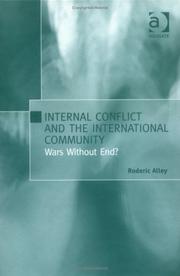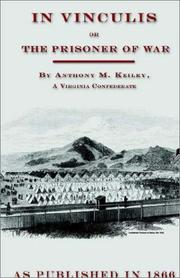| Listing 1 - 10 of 152 | << page >> |
Sort by
|
Book
ISBN: 1108762468 1108775896 1108781764 1108486762 Year: 2020 Publisher: Cambridge : Cambridge University Press,
Abstract | Keywords | Export | Availability | Bookmark
 Loading...
Loading...Choose an application
- Reference Manager
- EndNote
- RefWorks (Direct export to RefWorks)
Our understanding of civil war is shot through with the spectre of quagmire, a situation that traps belligerents, compounding and entrenching war's dangers. Despite the subject's importance, its causes are obscure. A pervasive 'folk' notion that quagmire is intrinsic to certain countries or wars has foreclosed inquiry, and scholarship has failed to identify quagmire as an object of study in its own right. Schulhofer-Wohl provides the first treatment of quagmire in civil war. In a rigorous but accessible analysis, he explains how quagmire can emerge from domestic-international interactions and strategic choices. To support the argument, Schulhofer-Wohl draws upon field research on Lebanon's sixteen-year civil war, structured comparisons with civil wars in Chad and Yemen, and rigorous statistical analyses of all civil wars worldwide fought between 1944 and 2006. The results make clear that the 'folk' notion misdiagnoses quagmire and demand that we revisit policies that rest upon it. Schulhofer-Wohl demonstrates that quagmire is made, not found.
Civil war. --- Civil wars --- Intra-state war --- Rebellions --- Government, Resistance to --- International law --- Revolutions --- War
Book
ISBN: 1108667309 1108655572 1108753957 1108497276 Year: 2020 Publisher: Cambridge : Cambridge University Press,
Abstract | Keywords | Export | Availability | Bookmark
 Loading...
Loading...Choose an application
- Reference Manager
- EndNote
- RefWorks (Direct export to RefWorks)
Civil war has been a fact of political life throughout recorded history. However, unlike inter-state wars, international law has not traditionally regulated such conflicts. How then can we explain the post-1945 emergence and evolution of international treaty rules regulating the conduct of internal armed conflict: the 'Civil War Regime'? Negotiating Civil War combines insights derived from Realist, Rationalist, Liberal, and Constructivist approaches to International Relations to answer this question, revisiting the negotiation of the 1949 Geneva Conventions, the 1977 Additional Protocols, and the 1998 Rome Statute of the International Criminal Court. This study provides a rigorous, critical account of the making of the Civil War Regime. Sophisticated and persuasive, it illustrates the complex interplay of material, ideational, social, and strategic factors in shaping these rules with important lessons for the making and unmaking of international law in a rapidly shifting international political, economic, and security environment.
Civil war. --- War (International law) --- Hostilities --- International law --- Neutrality --- Civil wars --- Intra-state war --- Rebellions --- Government, Resistance to --- Revolutions --- War
Book
ISBN: 1474401546 1474401538 Year: 2015 Publisher: Edinburgh University Press
Abstract | Keywords | Export | Availability | Bookmark
 Loading...
Loading...Choose an application
- Reference Manager
- EndNote
- RefWorks (Direct export to RefWorks)
Giorgio Agamben investigates the genealogy of the strife between the Polis and its population with particular regard to the Greek concept of stasis and the strife with the commonwealth of Hobbes' Leviathan. STASIS re-opens the questioning of the answers offered, from the pre-history of the power of the State all the way to the time after the end of its power and towards the renewed questioning of the state of power today.
Civil war --- Civil wars --- Intra-state war --- Rebellions --- Government, Resistance to --- International law --- Revolutions --- War --- Philosophy. --- Political aspects. --- Hobbes, Thomas,
Book
ISBN: 3030819930 3030819922 Year: 2021 Publisher: Cham, Switzerland : Palgrave Pivot,
Abstract | Keywords | Export | Availability | Bookmark
 Loading...
Loading...Choose an application
- Reference Manager
- EndNote
- RefWorks (Direct export to RefWorks)
Civil war --- Forecasting. --- Data processing. --- Prevention. --- Civil wars --- Intra-state war --- Rebellions --- Government, Resistance to --- International law --- Revolutions --- War
Book
ISBN: 9780415507905 9780203588918 9781135069223 9781135069209 9781135069216 9781138819733 0415507901 Year: 2013 Publisher: New York Routledge
Abstract | Keywords | Export | Availability | Bookmark
 Loading...
Loading...Choose an application
- Reference Manager
- EndNote
- RefWorks (Direct export to RefWorks)
Intervention (International law) --- Civil war --- Civil war. --- Civil wars --- Intra-state war --- Rebellions --- Government, Resistance to --- International law --- Revolutions --- War --- Military intervention --- Diplomacy --- Neutrality --- Intervention (International law).

ISBN: 0754609766 Year: 2004 Publisher: Aldershot Ashgate
Abstract | Keywords | Export | Availability | Bookmark
 Loading...
Loading...Choose an application
- Reference Manager
- EndNote
- RefWorks (Direct export to RefWorks)
Civil war --- Intervention (International law) --- Military intervention --- Civil wars --- Intra-state war --- Rebellions --- International law --- Polemology --- Diplomacy --- Neutrality --- Government, Resistance to --- Revolutions --- War

ISBN: 1582183228 9781582183220 1582183244 Year: 1866 Publisher: Petersburg, Va. "Daily index" Office
Abstract | Keywords | Export | Availability | Bookmark
 Loading...
Loading...Choose an application
- Reference Manager
- EndNote
- RefWorks (Direct export to RefWorks)
Civil war --- Civil wars --- Intra-state war --- Rebellions --- Government, Resistance to --- International law --- Revolutions --- War --- United States --- History --- Prisoners and prisons. --- Prisoners, Exchange of
Book
ISBN: 1626370826 9781626370821 9781588268273 1588268276 Year: 2022 Publisher: Boulder
Abstract | Keywords | Export | Availability | Bookmark
 Loading...
Loading...Choose an application
- Reference Manager
- EndNote
- RefWorks (Direct export to RefWorks)
Wars of secession, ethnic wars, rebellions, and mutinies have been part of the political landscape of the Democratic Republic of Congo since the country became independent in 1960. Why? And what can we learn from this seemingly unending series of internal conflicts? Emizet François Kisangani explores these fundamental questions within a rigorously systematic and uniquely comprehensive framework. Looking closely at five decades of civil wars in the DRC, Kisangani finds ample evidence to challenge popular paradigms. His focus on the politics of exclusion and his attention to both the micro- and macroprocesses of the wars provides an analytical lens through which not only the nature of civil wars, but also Congo’s politics more broadly, are brought into clearer focus.
Civil war --- Civil wars --- Intra-state war --- Rebellions --- Government, Resistance to --- International law --- Revolutions --- War --- History. --- Social aspects --- Congo (Democratic Republic) --- Politics and government
Book
ISBN: 1527500470 9781527500471 1527500470 Year: 2017 Publisher: Newcastle upon Tyne, UK : Cambridge Scholars Publishing,
Abstract | Keywords | Export | Availability | Bookmark
 Loading...
Loading...Choose an application
- Reference Manager
- EndNote
- RefWorks (Direct export to RefWorks)
This book identifies the conditions under which foreign countries intervene in civil wars, contending that we should consider four dimensions of civil war intervention. The first dimension is the civil war itself. The characteristics of the civil war itself are important determinants of a third party's decision making regarding intervention. The second dimension is the characteristics of intervening states, and includes their capabilities and domestic political environments. The third is the relationship between the host country and the intervening country. These states' formal alliances and the differences in military capability between the target country and the potential intervener have an impact on the decision making process. The fourth dimension is the relationship between the interveners. This framework of four dimensions proves critical in understanding foreign intervention in civil wars. Based on this framework, the model for the intervention mechanism can reflect reality better. By including the relationships between the interveners here, the book shows that it is important to distinguish between intervention on the side of the government and intervention on behalf of the opposition. Without distinguishing between these, it is impossible to consider the concepts of counter-intervention and bandwagoning intervention.
Civil war. --- Intervention (International law) --- Civil wars --- Intra-state war --- Rebellions --- Government, Resistance to --- International law --- Revolutions --- War --- Military intervention --- Diplomacy --- Neutrality
Book
ISBN: 9781847208088 Year: 2010 Publisher: Cheltenham Elgar
Abstract | Keywords | Export | Availability | Bookmark
 Loading...
Loading...Choose an application
- Reference Manager
- EndNote
- RefWorks (Direct export to RefWorks)
Polemology --- Civil war --- Peace-building --- Building peace --- Peacebuilding --- Conflict management --- Peace --- Peacekeeping forces --- Civil wars --- Intra-state war --- Rebellions --- Government, Resistance to --- International law --- Revolutions --- War
| Listing 1 - 10 of 152 | << page >> |
Sort by
|

 Search
Search Feedback
Feedback About UniCat
About UniCat  Help
Help News
News